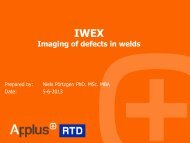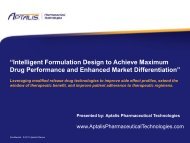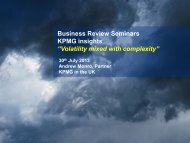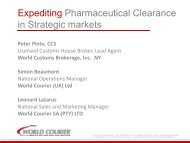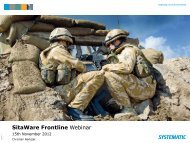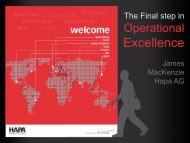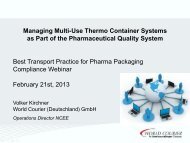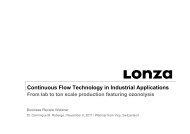Crystal - Business Review Webinars
Crystal - Business Review Webinars
Crystal - Business Review Webinars
You also want an ePaper? Increase the reach of your titles
YUMPU automatically turns print PDFs into web optimized ePapers that Google loves.
<strong>Crystal</strong> ,<br />
the Closed Vial Technology<br />
SAFER and EASIER Aseptic Filling<br />
<strong>Business</strong> <strong>Review</strong> Webinar<br />
September 28, 2011<br />
Confidential | Copyright © 2011 | Aseptic Technologies | All rights reserved
Key messages on <strong>Crystal</strong> ® Technology<br />
•Consists of two elements:<br />
–A ready to fill vial<br />
–A filling line piercing and re-sealing the<br />
stopper<br />
<strong>Crystal</strong> <br />
Technology<br />
•Has been fully validated for filling of aseptic<br />
drugs<br />
•Offers key advantages:<br />
–Safer for the patient<br />
–Easier for the manufacturer<br />
Confidential | Copyright © 2011 | Aseptic Technologies | All rights reserved
Aseptic filling: a complex process…<br />
GLASS VIAL FILLING<br />
vials<br />
stoppers<br />
Confidential | Copyright © 2011 | Aseptic Technologies | All rights reserved
… still risky for the patient<br />
Infections by contaminated drugs: 200,000<br />
infections per year (1/100,000 injections)<br />
Reduction of exposure to preservatives<br />
As a precautionary measure, the Public Health Service (FDA, NIH, CDC,<br />
HRSA) and the American Academy of Pediatrics issued two Joint<br />
Statements, urging vaccine manufacturers to reduce or eliminate<br />
thimerosal in vaccines as soon as possible (CDC 1999) and (CDC 2000).<br />
Confidential | Copyright © 2011 | Aseptic Technologies | All rights reserved
Challenges of Aseptic Technologies<br />
Aseptic filling is currently<br />
How to make it<br />
Still risky<br />
SAFER?<br />
More and more complex<br />
EASIER?<br />
Confidential | Copyright © 2011 | Aseptic Technologies | All rights reserved
New concept of <strong>Crystal</strong> ® | Process<br />
Molding site<br />
Irradiation unit<br />
Molding & Closing<br />
(ISO 5)<br />
Assembly<br />
(ISO 8)<br />
Sterilization<br />
(Gamma irradiation)<br />
Pharmaceutical site<br />
Filling line under barrier (ISO 5)<br />
Clean & sterile<br />
“ready to fill”<br />
vial<br />
Capping Laser re-sealing Filling<br />
Confidential | Copyright © 2011 | Aseptic Technologies | All rights reserved
Vial manufacturing process<br />
Confidential | Copyright © 2011 | Aseptic Technologies | All rights reserved
Closed vial filling line operations<br />
Confidential | Copyright © 2011 | Aseptic Technologies | All rights reserved
Six formats of vial available<br />
1 ml 2 ml 6 ml 10 ml 20 ml 50 ml<br />
Confidential | Copyright © 2011 | Aseptic Technologies | All rights reserved
Two formats of Laboratory lines<br />
<strong>Crystal</strong> M1<br />
Filling<br />
Station<br />
• Independent tools with manual<br />
operations<br />
• To be installed in existing environment<br />
• Designed to fill very small batch filling<br />
(
Three formats of Production lines<br />
<strong>Crystal</strong> Cx<br />
Filling line<br />
• Designed to fill medium scale<br />
commercial batches<br />
• Capacity: up to 75 vials/min*<br />
• Space needed: 40 m² (footprint: 9 m²)<br />
<strong>Crystal</strong> PX<br />
Filling line<br />
• Designed to fill commercial batches<br />
• Capacity: currently up to 150<br />
vials/min*, is expected to be increased<br />
• Space needed: 60 m² (footprint: 16 m²)<br />
<strong>Crystal</strong> Pxx<br />
Filling line<br />
• Designed to fill large commercial<br />
batches<br />
• Capacity: up to 600 vials/min*<br />
• Space needed: 100 m² (footprint: 44<br />
m²)<br />
* 1 ml vials<br />
• Capacity increase is feasible by adding<br />
filling heads and lasers<br />
Confidential | Copyright © 2011 | Aseptic Technologies | All rights reserved
Status of the<br />
Technology<br />
Confidential | Copyright © 2011 | Aseptic Technologies | All rights reserved
Status of product testing<br />
83 products filled in <strong>Crystal</strong> vial<br />
• Various categories tested, including<br />
– 56 biological products (vaccines, antibodies, proteins, cells, viruses,<br />
mRNA,…)<br />
– 7 cytotoxic products<br />
– 7 lyophilized products<br />
• 46 different companies, including<br />
– 4 top 10 pharma<br />
– 4 top 10 biotechs<br />
• Currently 73 results obtained<br />
– 27 products with better stability than with other containers<br />
– 9 products with lack of stability*<br />
– 39 products with good stability<br />
* 3 are unstable in glass as well, one unbuffered product was sensitive to acid, two are<br />
degraded due to oxygen ingress without protective packaging, one is hydrophobic, one is<br />
more absorbed than in PP but less than in glass and one is adsorbed<br />
Confidential | Copyright © 2011 | Aseptic Technologies | All rights reserved
Users of <strong>Crystal</strong> equipment worldwide<br />
Active users<br />
Equipment to be delivered<br />
* Projects not indicated are confidential<br />
Confidential | Copyright © 2011 | Aseptic Technologies | All rights reserved
First product approved<br />
• Product filled in late 2007 in AT facility (filling line in CVFS,<br />
located in ISO8 clean room)<br />
• Two years of stability obtained in early 2010, all data within<br />
specifications<br />
• Data submitted to EMA in January 2011, CHMP recommended<br />
approval in May 2011 with sentences such as “…very<br />
interesting innovative technique…”, approval granted by EMA<br />
in July 2011<br />
Confidential | Copyright © 2011 | Aseptic Technologies | All rights reserved
They talk about us ...<br />
“Certain modern manufacturing designs (isolators 1 and<br />
"closed vial" filling) afford isolation of the aseptic process<br />
from microbiological contamination risks (e.g., operators and<br />
surrounding room environment) throughout processing.”<br />
1 This does not apply to RABS (Restricted Access Barrier Systems)<br />
http://www.fda.gov/Drugs/GuidanceComplianceRegulatoryInformation/Guidances/ucm124782.htm<br />
"Can the Closed Vial filling equipment be surrounded by<br />
Grade C environment? I would say "Yes" because the vials<br />
are permanently closed"<br />
Personal opinion from Dr. Jean-Denis Mallet (Former Head of the Pharmaceutical, API and<br />
Cosmetics Inspection Department at the French Health Products Regulatory Agency<br />
(AFSSAPS) ) expressed at European Compliance Academy, Dusseldorf, March 10, 2010<br />
Simply Safer !<br />
Confidential | Copyright © 2011 | Aseptic Technologies | All rights reserved
Major Advantages<br />
SAFER<br />
+<br />
EASIER<br />
Confidential | Copyright © 2011 | Aseptic Technologies | All rights reserved
Some important vial properties<br />
Anticounterfeiting<br />
possibilities<br />
Large piercing area<br />
secured by V-<br />
pressure rib<br />
No silicone,<br />
very limited<br />
leachables<br />
Resistant to<br />
damages<br />
Closed<br />
container<br />
V-pressure rib,<br />
suitable for very<br />
low temperature<br />
storage<br />
Stopper designed<br />
to minimize<br />
residual volume of<br />
liquid<br />
Vial = isolator at item level<br />
Confidential | Copyright © 2011 | Aseptic Technologies | All rights reserved
Key advantages of <strong>Crystal</strong> ® Technology<br />
SAFER<br />
EASIER<br />
INCREASE<br />
PROFIT<br />
For whom?<br />
• For your regulatory<br />
team<br />
• For your supply chain<br />
team<br />
• For your<br />
manufacturing team<br />
• For your QA/QC team<br />
• For your marketing<br />
team<br />
• For your financial team<br />
• For your<br />
manufacturing team<br />
• For your sales team<br />
Why?<br />
• Provide a top-class sterility assurance<br />
level thanks to a closed ready to fill<br />
container<br />
• Secure the products inside an<br />
unbreakable and coded container<br />
• Simplify entire filling process (lean<br />
manufacturing)<br />
• Reduce initial and regular validation<br />
work<br />
• Facilitate handle by healthcare<br />
specialists<br />
• Reduce capital expenses<br />
• Reduce operating expenses<br />
despite vials more expensive than<br />
unclean non-sterile glass vials<br />
• Boost sales thanks to better perception<br />
by end-users<br />
Confidential | Copyright © 2011 | Aseptic Technologies | All rights reserved
Key advantages of <strong>Crystal</strong> ® Technology<br />
SAFER<br />
EASIER<br />
INCREASE<br />
PROFIT<br />
For whom?<br />
• For your regulatory<br />
team<br />
• For your supply chain<br />
team<br />
• For your<br />
manufacturing team<br />
• For your QA/QC team<br />
• For your marketing<br />
team<br />
• For your financial team<br />
• For your<br />
manufacturing team<br />
• For your sales team<br />
Why?<br />
• Provide a top-class sterility assurance<br />
level thanks to a closed ready to fill<br />
container<br />
• Secure the products inside an<br />
unbreakable and coded container<br />
• Simplify entire filling process (lean<br />
manufacturing)<br />
• Reduce initial and regular validation<br />
work<br />
• Facilitate handle by healthcare<br />
specialists<br />
• Reduce capital expenses<br />
• Reduce operating expenses<br />
despite vials more expensive than<br />
unclean non-sterile glass vials<br />
• Boost sales thanks to better perception<br />
by end-users<br />
Confidential | Copyright © 2011 | Aseptic Technologies | All rights reserved
Impact of open glass vials and inappropriate materials<br />
FDA identified steel, rubber and fiber particles in vials filled at<br />
Genzyme Allston site<br />
Despite that Genzyme claimed that vials with particles are<br />
identified and eliminated, the FDA decided to:<br />
• Refuse approval for manufacturing of Lumizyme<br />
• Recommend close inspection by healthcare practitioners for 5<br />
drugs including Cerezyme and Fabrazyme<br />
Amgen identified flakes of glass in EPO vials due to ageing<br />
Amgen and J&J withdrew respectively 200 and 155 lots from the<br />
market<br />
Shelf-life has been reduced from 36 to 12 months<br />
Hospira identified metal particles in Liposyn and Propofol vials<br />
Hospira withdrew 85 lots of Liposyn and 73 lots of Propofol from<br />
the market<br />
Confidential | Copyright © 2011 | Aseptic Technologies | All rights reserved
Exposure to environment<br />
From hot-air tunnel up<br />
to stoppering<br />
> 30 minutes in most<br />
cases<br />
From loading up to stoppering,<br />
critical surface in direct<br />
contact with bowl and ramps<br />
From few minutes up to hours<br />
Exposed all along the<br />
process but no contact<br />
Never open<br />
except during<br />
piercing<br />
Exposed all along the<br />
process and in contact<br />
with stopper surface<br />
Wiped during entry<br />
inside vial<br />
Confidential | Copyright © 2011 | Aseptic Technologies | All rights reserved
Exposure risks<br />
Contaminated containers per million if 1 cfu every 1000 m³<br />
Glass vial<br />
30.7<br />
Open ampoule<br />
Prefilled syringe<br />
5.5<br />
8.1<br />
<strong>Crystal</strong> vial<br />
Blow-fill-seal<br />
0.20<br />
0.12<br />
Risk of contamination is reduced<br />
~150 times compared to classical<br />
glass vial<br />
Grade A = < 1 cfu/m³<br />
Confidential | Copyright © 2011 | Aseptic Technologies | All rights reserved
Particles comparison between glass vial and closed vial<br />
Vials having faced full filling and collection process<br />
Number of particles<br />
Closed vial in CVFL<br />
Glass vial in isolator<br />
Particles ≥5 µm<br />
Particles ≥10 µm<br />
Particles ≥25 µm<br />
600<br />
60<br />
6<br />
500<br />
428<br />
50<br />
47<br />
5<br />
400<br />
40<br />
4<br />
300<br />
237<br />
30<br />
23<br />
3<br />
200<br />
20<br />
2<br />
100<br />
10<br />
1<br />
1<br />
1<br />
0<br />
0<br />
Particles reduced by a factor 2<br />
compared to glass vials filled in isolator<br />
0<br />
Confidential | Copyright © 2011 | Aseptic Technologies | All rights reserved
Leachables | <strong>Crystal</strong> ® Closed Vial<br />
Leachables in WFI*<br />
Range<br />
From 10 ppm to 50 ppm<br />
From 5 ppm to 10 ppm<br />
From 1 ppm to 5 ppm<br />
Less than 1 ppm<br />
T = 24 months<br />
Acetic acid<br />
Formic acid<br />
t-butanol<br />
Very few products. No concern<br />
with toxicity and carcigenocity<br />
<strong>Crystal</strong> ® vials are also<br />
- latex free<br />
- silicone free<br />
Very few leachables.<br />
No toxicity concern, according to FDA recommended expert<br />
* Similar results obtained in ethanol 10%, PBS, NaCl 0.9% and 2-phenoxyethanol 0.5%<br />
Confidential | Copyright © 2011 | Aseptic Technologies | All rights reserved
Typical leachables from other containers<br />
2-methylpentane<br />
3-methylpentane<br />
Hexane (class 2 solvent*)<br />
Methylcyclopentane<br />
Cyclohexane (Class 2 solvent*)<br />
Butylated Hydroxytoluene (BHT)<br />
Lauric acid<br />
Palmitic acid<br />
Myristic acid<br />
Stearic acid<br />
Aliphatic alcohols (Class 3 solvent*)<br />
Dibutylamine (10-50ppm, Permitted<br />
Daily Dose for infant is 11 µg)<br />
Metal ions including<br />
Barium<br />
Arsenic<br />
Alkali compounds<br />
Flakes of glass due to<br />
product aggression<br />
Silicon oil<br />
Tungstene<br />
Vulcanizing agents<br />
Glass components as for<br />
vials<br />
High surface/volume ratio<br />
increasing risk<br />
* According to ICH Q3C guideline : class 1 = highly toxic solvent, class 2 = toxicity proven<br />
at low dose, class 3 = toxicity at higher dose.<br />
Sources: Biopharm International (April 2010), J Radioanal. Nucl. Chem. (2004),<br />
AAPS (2007), Drug Safety Institute, J Pharm. Sc. (1986)<br />
Confidential | Copyright © 2011 | Aseptic Technologies | All rights reserved
Key advantages of <strong>Crystal</strong> ® Technology<br />
SAFER<br />
EASIER<br />
INCREASE<br />
PROFIT<br />
For whom?<br />
• For your regulatory<br />
team<br />
• For your supply chain<br />
team<br />
• For your<br />
manufacturing team<br />
• For your QA/QC team<br />
• For your marketing<br />
team<br />
• For your financial team<br />
• For your<br />
manufacturing team<br />
• For your sales team<br />
Why?<br />
• Provide a top-class sterility assurance<br />
level thanks to a closed ready to fill<br />
container<br />
• Secure the products inside an<br />
unbreakable and coded container<br />
• Simplify entire filling process (lean<br />
manufacturing)<br />
• Reduce initial and regular validation<br />
work<br />
• Facilitate handle by healthcare<br />
specialists<br />
• Reduce capital expenses<br />
• Reduce operating expenses<br />
despite vials more expensive than<br />
unclean non-sterile glass vials<br />
• Boost sales thanks to better perception<br />
by end-users<br />
Confidential | Copyright © 2011 | Aseptic Technologies | All rights reserved
Drop test<br />
Results with 10 ml vials<br />
(filled with 10 ml mannitol 15%)<br />
120<br />
% of vials<br />
100<br />
<strong>Crystal</strong> vials<br />
without visual<br />
product leak<br />
80<br />
60<br />
40<br />
<strong>Crystal</strong> vials<br />
without damage<br />
Glass vial after<br />
50 cm drop<br />
20<br />
0<br />
Non exploded<br />
glass vials<br />
0 1 2 3 4 5<br />
• At table height: ~1/2 glass vial are broken<br />
• At chest height: almost all glass vials are broken<br />
• <strong>Crystal</strong> vials are still intact at 2 meter height<br />
Meter for drop test<br />
• In case of damage, usually <strong>Crystal</strong> vial does not spread the product<br />
Confidential | Copyright © 2011 | Aseptic Technologies | All rights reserved
Drop test<br />
Results with small vials<br />
(2R glass vial and 1ml <strong>Crystal</strong> vial, filled with 1 ml mannitol 15%)<br />
120<br />
% of vials<br />
100<br />
80<br />
<strong>Crystal</strong> vials<br />
without damage<br />
60<br />
40<br />
20<br />
0<br />
Non exploded<br />
glass vials<br />
0 1 2 3 4 5 10 6<br />
• At table height: risk of glass vial breakage is<br />
present<br />
• <strong>Crystal</strong> vials are still intact over 10 meter height<br />
Meter for drop test<br />
Confidential | Copyright © 2011 | Aseptic Technologies | All rights reserved
Freeze-thawing<br />
Results after freezing at -70°C and thawing at RT<br />
(filled with mannitol 15%)<br />
% of intact<br />
vials<br />
120<br />
100<br />
80<br />
5 ml glass<br />
vials*<br />
All format of <strong>Crystal</strong><br />
vials (5, 10 and 20 ml)<br />
60<br />
40<br />
10 ml glass<br />
vials*<br />
<strong>Crystal</strong> vials<br />
under thawing<br />
process<br />
20<br />
0<br />
20 ml glass vials*<br />
0 20 40 60 80 100<br />
% nominal volume filled<br />
• <strong>Crystal</strong> vials are very resistant to product expansion,<br />
but not glass vials<br />
• Bigger is the glass vial, more fragile it is<br />
* published data: Jiang et al., PDA J. Pharm. Sc. And Technol., 61, 441-451 (2007)<br />
Confidential | Copyright © 2011 | Aseptic Technologies | All rights reserved
Secured traceability and anti-counterfeiting<br />
Examples of secured coding technologies<br />
On-line coding of RFID<br />
secured under the cap<br />
On-line laser coding on top ring<br />
Alpha<br />
numeric<br />
2D matrix<br />
Fully secured vial<br />
through on-line coding<br />
Confidential | Copyright © 2011 | Aseptic Technologies | All rights reserved
Key advantages of <strong>Crystal</strong> ® Technology<br />
SAFER<br />
EASIER<br />
INCREASE<br />
PROFIT<br />
For whom?<br />
• For your regulatory<br />
team<br />
• For your supply chain<br />
team<br />
• For your<br />
manufacturing team<br />
• For your QA/QC team<br />
• For your marketing<br />
team<br />
• For your financial team<br />
• For your<br />
manufacturing team<br />
• For your sales team<br />
Why?<br />
• Provide a top-class sterility assurance<br />
level thanks to a closed ready to fill<br />
container<br />
• Secure the products inside an<br />
unbreakable and coded container<br />
• Simplify entire filling process (lean<br />
manufacturing)<br />
• Reduce initial and regular validation<br />
work<br />
• Facilitate handle by healthcare<br />
specialists<br />
• Reduce capital expenses<br />
• Reduce operating expenses<br />
despite vials more expensive than<br />
unclean non-sterile glass vials<br />
• Boost sales thanks to better perception<br />
by end-users<br />
Confidential | Copyright © 2011 | Aseptic Technologies | All rights reserved
Process simplification<br />
GLASS VIAL FILLING<br />
vials<br />
stoppers<br />
<strong>Crystal</strong> ® FILLING<br />
Lean<br />
manufacturing<br />
Confidential | Copyright © 2011 | Aseptic Technologies | All rights reserved
Key advantages of <strong>Crystal</strong> ® Technology<br />
SAFER<br />
EASIER<br />
INCREASE<br />
PROFIT<br />
For whom?<br />
• For your regulatory<br />
team<br />
• For your supply chain<br />
team<br />
• For your<br />
manufacturing team<br />
• For your QA/QC team<br />
• For your marketing<br />
team<br />
• For your financial team<br />
• For your<br />
manufacturing team<br />
• For your sales team<br />
Why?<br />
• Provide a top-class sterility assurance<br />
level thanks to a closed ready to fill<br />
container<br />
• Secure the products inside an<br />
unbreakable and coded container<br />
• Simplify entire filling process (lean<br />
manufacturing)<br />
• Reduce initial and regular validation<br />
work<br />
• Facilitate handle by healthcare<br />
specialists<br />
• Reduce capital expenses<br />
• Reduce operating expenses<br />
despite vials more expensive than<br />
unclean non-sterile glass vials<br />
• Boost sales thanks to better perception<br />
by end-users<br />
Confidential | Copyright © 2011 | Aseptic Technologies | All rights reserved
Market research results <strong>Crystal</strong> ® vs. glass vials<br />
<strong>Crystal</strong> preferred No preference Glass preferred<br />
• 246 healthcare professionals from hospital settings interviewed<br />
• 71 doctors, 161 nurses and 14 hospital pharmacists<br />
• 134 in Europe (F, B) and 110 in the US (West and East Coasts)<br />
87% of professionals prefer <strong>Crystal</strong> ®<br />
87 6 7<br />
In each region<br />
By each professional<br />
Europe<br />
USA<br />
89<br />
6 5<br />
85 5 10<br />
Doctors<br />
Nurses<br />
Pharm.<br />
90<br />
85<br />
86<br />
4 6<br />
6 9<br />
14<br />
Full presentation available on request<br />
Confidential | Copyright © 2011 | Aseptic Technologies | All rights reserved
Preference drivers<br />
•87% of professionals expressed a preference for<br />
<strong>Crystal</strong> <br />
•What are the drivers of this preference?<br />
Easy to handle<br />
45<br />
Shock-resistance<br />
36<br />
Easy to open<br />
Asepsis improvement<br />
Easy to pierce<br />
Easier in general<br />
26<br />
23<br />
21<br />
18<br />
Vial stability<br />
11<br />
Secured marking<br />
4<br />
“Delivery systems that score high with end-users may provide a<br />
competitive edge as pharmaceutical companies start sharpening their<br />
life cycle management tools” M. Romacker, Amgen Inc.<br />
Full presentation available on request<br />
Confidential | Copyright © 2011 | Aseptic Technologies | All rights reserved
Key advantages of <strong>Crystal</strong> ® Technology<br />
SAFER<br />
EASIER<br />
INCREASE<br />
PROFIT<br />
For whom?<br />
• For your regulatory<br />
team<br />
• For your supply chain<br />
team<br />
• For your<br />
manufacturing team<br />
• For your QA/QC team<br />
• For your marketing<br />
team<br />
• For your financial team<br />
• For your<br />
manufacturing team<br />
• For your sales team<br />
Why?<br />
• Provide a top-class sterility assurance<br />
level thanks to a closed ready to fill<br />
container<br />
• Secure the products inside an<br />
unbreakable and coded container<br />
• Simplify entire filling process (lean<br />
manufacturing)<br />
• Reduce initial and regular validation<br />
work<br />
• Facilitate handle by healthcare<br />
specialists<br />
• Reduce capital expenses<br />
• Reduce operating expenses<br />
despite vials more expensive than<br />
unclean non-sterile glass vials<br />
• Boost sales thanks to better perception<br />
by end-users<br />
Confidential | Copyright © 2011 | Aseptic Technologies | All rights reserved
Cost savings using the closed vial<br />
Capital expenses<br />
Vials<br />
API<br />
Filling line<br />
Total cost<br />
of filled vial<br />
Operating expenses<br />
Confidential | Copyright © 2011 | Aseptic Technologies | All rights reserved
Reduction of API expenses<br />
Residual<br />
volume = 12 µl<br />
Residual<br />
Volume = 3 µl<br />
Difference = 9µl<br />
0.09 USD saving per vial<br />
if API price is 10 USD/ml<br />
<strong>Crystal</strong> ® vial stopper specially designed to ease<br />
liquid collection and to reduce API expenses<br />
Confidential | Copyright © 2011 | Aseptic Technologies | All rights reserved
Conclusions<br />
Confidential | Copyright © 2011 | Aseptic Technologies | All rights reserved
Closed vial characteristics<br />
•The Closed Vial technology provides a safer solution<br />
to the patient<br />
•The Closed Vial technology simplify the entire filling<br />
process<br />
•The regulatory authorities have well understood the<br />
advantages of this technology compared to classical<br />
ones<br />
Simply Safer !<br />
Confidential | Copyright © 2011 | Aseptic Technologies | All rights reserved









